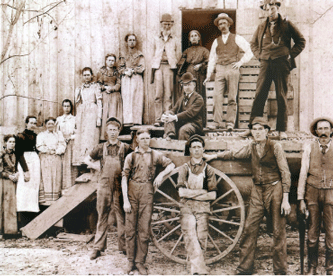|
Apple Evaporators
Yates Past - October 2005
New York’s 2005 apple harvest is well underway. Predictions are that it will be an above average harvest for the third consecutive year. In 2004 the state produced 30 million bushels, about a third of which was shipped out of the country in refrigerated trucks (to Canada and Mexico) and overseas in refrigerated ship containers.
 The McAlpine evaporator (circa 1905)
The McAlpine evaporator (circa 1905)
Ezra to the left of the door and
Will in front of it with the flat-brimmed hat.
Ezra’s wife Kate between them. |
Apples have been important to Yates County’s agricultural economy since the 19th Century, although production declined in the 20th Century. As counties in other parts of the state took the lead in apple production, farmers in this county converted over to other crops. Apple growers here today generally grow for the local market and don’t have to be too concerned with long distance shipping. Such was not the case a hundred years ago. Before refrigerated shipping was in widespread use, apples needed to be dried in evaporators and packed in barrels before they could be shipped any distance (usually by railroad).
A hundred years ago, there were several fruit evaporators spread throughout Yates County. There were larger operations in the villages of Penn Yan, Dundee, Dresden, and Rushville but most of the evaporators were located on the farms of people who were looking to pick up some extra income by processing their neighbor’s crops. Such was the case in my own family. Ezra McAlpine (my G G grandfather) and his son Will ( my great grandfather) shared a farm in the Town of Starkey on what today is called Beartown Road on the hill above Glenora. Most of their production went into apples and berries. From diaries kept in the family, I know that Ezra and Will had an evaporator (which they called the “dryer”) going back into the 1880s. It was a part of one of their barns. During the apple harvest, family members or hired hands would peel, core, and slice the apples to prepare them for drying. The dryer consisted of a large fire above which were a series of wooden racks with slats. The apples would be treated with sulfur so they wouldn’t turn brown and spread out on the racks to be dried. Three or four times during the process they were turned with a wooden shovel. When they were done, they were loaded into wooden barrels and taken to the railroad depot at Rock Stream to be shipped. In 1898, Ezra and Will decided to go “big time”. They built a larger evaporator and offered to buy apples from other farmers in Starkey to process and sell. They ran an ad in the Dundee Observer.....”DROP APPLES WANTED for paring and chopping. Highest market price in cash. E. McAlpine & SON”. Within a few months, this article ran in the Observer (November 23, 1898):
On the 19th of last August, E. McAlpine & Son of this town started their evaporator which, by the way, is the largest in this section. Since that time, they havebeen constantly engaged in evaporating apples, many of which were purchased abroad and shipped here in carload lots. They expect to finish the season’s work next week when they will have handled and dried 10,000 bushels which yields them 50 tons of dried stock. From 15 to 20 hands were employed to operate the plant.
The evaporator business was not without risk. Using fires in old barns (not constantly tended), there was a constant threat of fire. Based on the family diaries, there were at least three times when the dryer burned down....either partially or entirely. Ezra McAlpine eventually lost his farm around World War I. He borrowed from the bank (using the farm as collateral) in order to buy the apples that were processed and then paid the loans off when they were sold. In 1917 the Dundee State Bank took over the farm and sold it to the Lawson family who still own and operate it to the best of my knowledge. Oral history passed down through their family included the story that Ezra had a lawn loaded with bushels and crates of apples awaiting processing. An early and hard freeze one October night ruined much of what was there. Ezra, who was well up in years at that time, went to live out the rest of his life on his son’s farm on the other side of Big Stream.
Evaporators were used well into the 20th Century until refrigerated shipping became more widespread. Jim Allen, the President of the New York Apple Association, reports that there are at least two still in operation in New York..... Atwater Foods in Lyndonville and Cahoon Farms in Wolcott. Most of their dried apples are sold to bakeries.
by Rich MacAlpine
|
